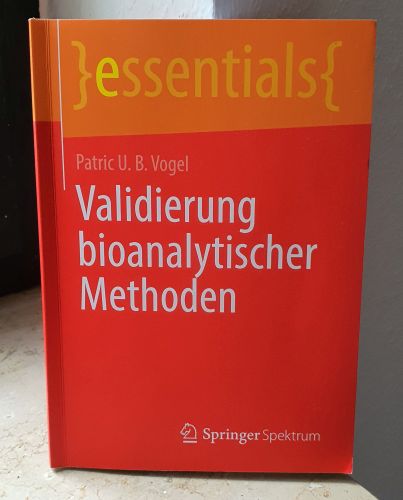Review of the book “Validierung bioanalytischer Methoden" (Validation of bioanalytical methods)

Small book - small review ;-) ?
Well, not exactly...
I'm going to reveal myself now - as a fan of the “essentials” series! Therefore, I‘d like to talk today about the book "Validation of Bioanalytical Methods" by Patric U.B. Vogel, which was published in 2020 by Springer Spektrum, Wiesbaden (ISBN: 978-3-658-31951-9).
This booklet contains 55 pages (including literature), can be read in a jiffy and gets straight to the heart of the matter in compact form. What I particularly like about this book series, apart from the small number of pages, is the concept of "getting in and out" of the book. It simply appeals to me when - already prior to the table of contents (and I am an avid table of contents reader) - 5 bullet points at one page tell me what to expect and a 9-line-summary makes me curious to read the book. It's the same at the end of the book, when again a few closing bullet points highlight the things I could take away and I just can agree...
But let's get to the content. I admit that the title "Validation of bioanalytical methods" initially misled me somewhat and made me immediately think of validations of quantitative determinations in biological matrices in the sense of the ICH M10. However, this is not what is meant at all, but the book deals with bioanalytical methods à la Lottspeich, i.e. methods for the analysis of biomolecules such as proteins, nucleic acids, carbohydrates and lipids, and in a broader sense viruses and cells. After pushing aside my initial irritation, I really liked the structure with introduction, followed by the method categories according to the ICH Q2(R1), the explanation of the individual validation parameters, a look into the surroundings, the selected validation examples, and potential consequences of insufficient method validations (keyword: warning letters). In particular, the chapter on the validation environment provides a brief GMP outline and helps to place the validation of analytical methods in the correct context and to understand the background. The chapter on the effects of inadequate method validation was also very interesting, although it should be noted that it doesn’t deal exclusively with validation violations only but with analytical and quality control violations in general, but it clearly shows how much the authorities focus on analytics.
To complain a little bit, I’ve got to mention that this booklet is teeming with spelling and grammatical errors, a reference is missing, the bibliography is not arranged stringently in alphabetical order, and there are also two little things to be chalked up in terms of content. First, the terms "validation" and "verification" (--> for compendial methods!) are not clearly distinguished from each other, and “validation” is even used when talking about compendial methods causing raise of my hackles... And second, I lack a clear distinction between a content determination and a potency assay, even though both belong to the same method category. Sometimes this appears a bit fuzzy. For example, in case my drug is an enzyme, I can determine the protein content with a simple photometric determination, but this doesn’t allow any statement about whether my enzyme is active or has potentially been damaged due to incorrect folding. Only after demonstration by an enzyme activity test (= potency assay) that my enzyme is fulfilling its function to the desired extent, I can be sure of its potency.
But I don't want to complain so much, that wouldn’t do justice to the book, because overall it is simply super. Particularly noteworthy is the understandable, relatively simple language and the huge amount of demonstrative and well-explained examples. Speaking of examples: the explanation of the validation parameters and the performance of validations in general based on the well-chosen bioanalytical methods per method category (except for a potency assay) were my highlight of the book.
Update 07/25/2022
After having read also the booklet "Quality control of vaccines" in the meantime, I’ve found an explanation for the equal treatment of a content determination and a potency test chalked up by me above: The author has vaccine glasses on ;-) In the case of e.g. live vaccines, a virus titration as a content determination simultaneously provides information about potency.
